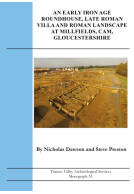Excavations at Cippenham, Slough, Berkshire (Paperback)
Imprint: Thames Valley Archaeological Services
Series: TVAS Monograph Series
Pages: 158
ISBN: 9780954400620
Published: 12th November 2003
Script Academic & Professional
Series: TVAS Monograph Series
Pages: 158
ISBN: 9780954400620
Published: 12th November 2003
Script Academic & Professional
Usually available in 6-8 weeks.
You'll be £10.00 closer to your next £10.00 credit when you purchase Excavations at Cippenham, Slough, Berkshire. What's this?
+£4.99 UK Delivery or free UK delivery if order is over £40
(click here for international delivery rates)
Order within the next 4 hours, 58 minutes to get your order processed the next working day!
Need a currency converter? Check XE.com for live rates
(click here for international delivery rates)
Order within the next 4 hours, 58 minutes to get your order processed the next working day!
Need a currency converter? Check XE.com for live rates
Volume 3 explores a series of multi-period sites that cover an extensive landscape to the south of Slough, tracing development from the Neolithic to the Medieval period. A major housing development on the 'Cippenham Sector' at Slough provided opportunities for archaeological excavations on several sites. The remains uncovered span some 6000 years from the early Neolithic to the Post-medieval period and reveal the changing face of this Thames Valley landscape under almost constant human influence throughout this time.
Earlier Neolithic evidence seems to relate mainly to domestic occupation, although the patterns of deposition suggest a ritual component. Later Neolithic activity is less abundant and less easily characterized but may also include ritual aspects. This theme continues into the Bronze Age, with a ring ditch and numerous cremation burials, both in a cemetery and also spread across the landscape. There is some evidence for occupation in the Middle Bronze Age, but more substantial occupation remains appear in the Later Bronze Age.
From the Middle Iron Age until the middle Roman period, the area appears to have been more or less continuously farmed, with remarkable continuity through this span, when it is more usual to expect marked breaks in the rural landholding pattern. The landscape in this period was dominated by small individual farms. An apparent abandonment in the 3rd century AD led to a remodelling and a lessening of the intensity of all kinds of activity, eventually leading to a total lack of evidence from the 4th century into the Saxon period. By medieval times, occupation was concentrated in one small part of the area investigated. It is likely that by this time most of the land was included in Cippenham Deer Park.
Other titles in the series...
Other titles in Thames Valley Archaeological Services...










